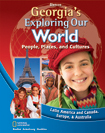

Exploring Our World: Latin America and Canada, Europe, and Australia © 2012 Georgia EditionChapter 7: CanadaChapter OverviewsCanada lies north of the United States and stretches to the Arctic Ocean. There are four main geographic regions in Canada: the highlands of the east; a massive plateau in the center that is surrounded by lowlands; a western region of mountains, plateaus, and valleys; and a few thousand islands in the far north. Canada shares all the Great Lakes with the United States, except Lake Michigan, which lies entirely within the U.S. The St. Lawrence Seaway links the Great Lakes with the Atlantic Ocean. Canada's climate zones vary from extremely cold in the north to more temperate in the south. Consequently, most Canadians live in the nation's southern regions and on its milder west coast. Abundant resources, such as oil, natural gas, coal, and minerals, along with timber and fishing industries, contribute to Canada's strong economy. Originally settled by Native American groups, Canada was not explored until the 1500s when France and England established colonies there. The French colony was called New France. After fighting between the British and the French, by the 1760s, the British controlled most of New France. Great Britain continued to govern Canada until 1867, when Canada became a dominion and formed its own government. Canada is a parliamentary democracy. Voters elect representatives to parliament, and the representatives choose the head of government, the prime minister. Although the country is still officially ruled by the British monarch, Canadians run their own affairs. With its vast size and many cultures, it has been difficult for Canada to forge a national identity. Because of its colonial roots in both France and England, Canada has two official languages: French and English. Canada is also home to people of Asian, African, and Latin American backgrounds. One of the First Nations in Canada, the Inuit, live in the Nunavut Territory. They govern themselves and speak the Inuit language. Canadian culture and art reflect the influences of both the early European settlers and the native peoples. Hockey, which began in Canada, continues to be a national pastime. Like the United States, Canada has a free market economy. People can buy and sell whatever they wish, and they can work wherever they wish. Canada has a large economy that includes fishing, manufacturing, forestry, ranching, agriculture, and the production of their energy resources, including natural gas, coal, and oil. The three North American countries—Canada, Mexico, and the United States—signed the North American Free Trade Agreement (NAFTA) in 1994 to erase trade barriers among the countries. As a result, much of Canada's trade is with the United States. Canada enjoys a trade surplus—it earns more from exported goods than it spends on imported goods. |  |















